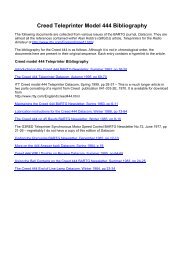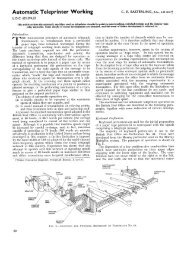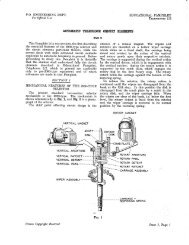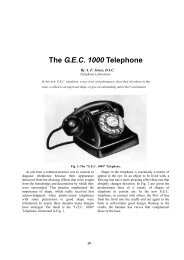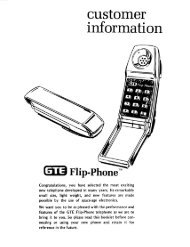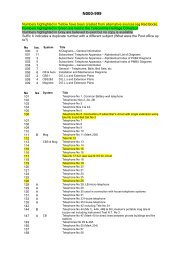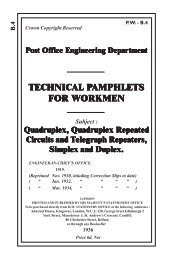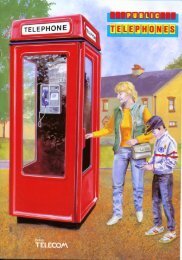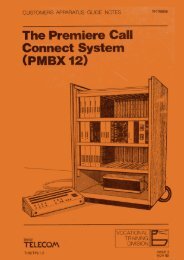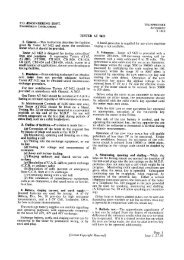TRAFFIC CONTROL TELEPHONE SYSTEMS Circuit - Sam Hallas
TRAFFIC CONTROL TELEPHONE SYSTEMS Circuit - Sam Hallas
TRAFFIC CONTROL TELEPHONE SYSTEMS Circuit - Sam Hallas
You also want an ePaper? Increase the reach of your titles
YUMPU automatically turns print PDFs into web optimized ePapers that Google loves.
from Line switch SC banks 1 and 2 at contact 40, causing Line switch SC to stop on<br />
this contact and leaving the line battery connected to line. A special time signal unit<br />
would be provided to operate Relay SR direct, and this would cause the selectors to<br />
be stepped to and past the special time signal ringing contact to give the required<br />
code. When the Controller releases the Time Sending key, Relay GCA at GCA1 reconnects<br />
positive to Line switch SCI/2 bank contact 40, restoring the drive circuit of<br />
Line switch SC which drives to normal. Relay TS is also released by the restoration<br />
of the Time Sending key, and at TS2 removes the positive connection from Line<br />
Switch SC6 bank contacts 40,42, 44. When Line switch SC drives over these bank<br />
contacts, Relay IS is alternately operated and released via SC bank contacts 41-45<br />
sending 6 reverse impulses to line via Relay SR contacts. These 6 impulses step the<br />
selectors clear of the time holding bar and all selectors return to normal.<br />
Special Adjustments<br />
(a) Line switch SC driving speed should be adjusted so that three complete<br />
revolutions of the wipers take approximately 20 seconds. To increase the speed,<br />
rheostat YJ should be turned in a clockwise direction, and to decrease the speed, turn<br />
in a counter-clockwise direction.<br />
(b) It is essential that the line battery positive and negative impulses sent to line<br />
should be of equal duration. The facility to test this is incorporated in the line testing<br />
set. If it is necessary to adjust this impulse duration, rheostat YH should be adjusted.<br />
To increase the time Relay SR is on its back contacts, the rheostat YH adjusting screw<br />
should be turned in a clockwise direction.<br />
Line Battery <strong>Circuit</strong> Breaker Indication and Reset Cabinet<br />
The circuit breaker Relay CB is operated via its 2,000 ohm winding when the<br />
non-locking key CBK in one or other of the cabinets is operated, and provided switch<br />
SC is in the home position. The Relay CB mechanically latches in the operated<br />
position and releases if the current in the CB Relay 2 ohm winding exceeds 500<br />
milliamps. CBI released lights the circuit breaker ‘out’ indicator lamps in the cabinet.<br />
A spark quencher circuit is provided across CB contacts 3 and 2 via resistor YK and<br />
capacitor QJ.<br />
Engaged Lamp<br />
A lamp, LP, is provided on each selective circuit apparatus panel to indicate<br />
when the apparatus is engaged. If the selective apparatus is unjacked and removed,<br />
Jack contacts 5 and 7 make together and light all engaged lamps on the Switch Sets via<br />
BNX, Jack points 5 and 7 to BBX. Contacts G1 and LC1 keep the lamp alight after<br />
the circuit key is restored to normal whilst the switches, etc., are returning to their<br />
normal position.<br />
Page 47



